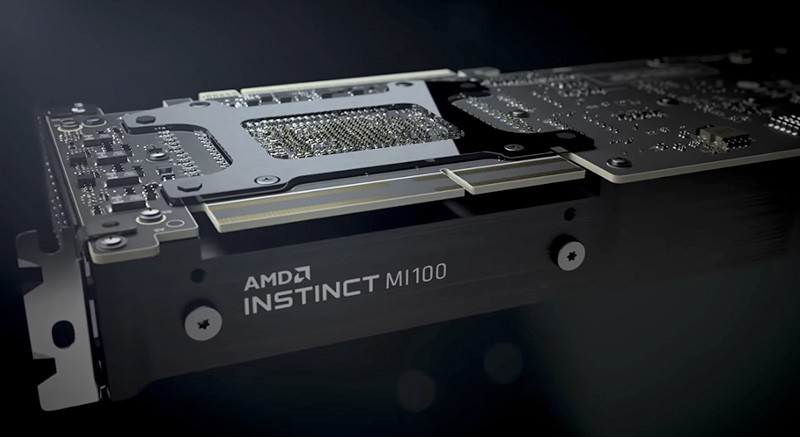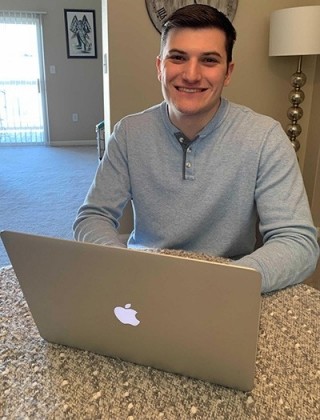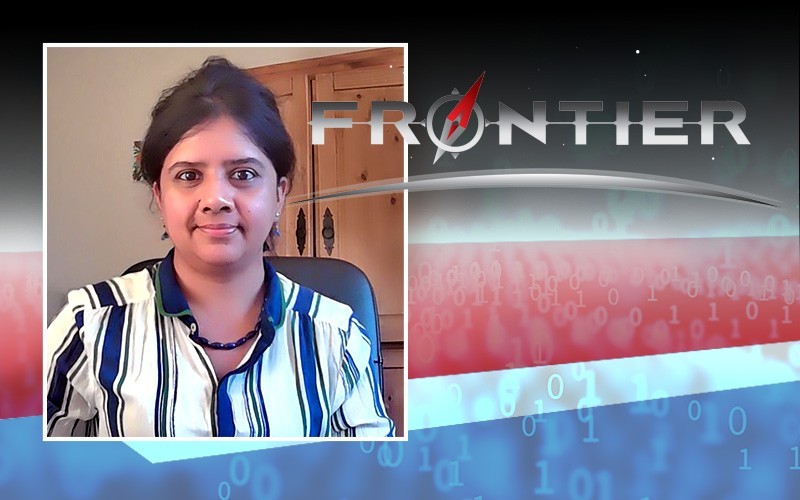UD’s Chandrasekaran leads team on the exascale frontier
What’s it like designing an app for the world’s fastest supercomputer, set to come online in the United States in 2021? The University of Delaware’s Sunita Chandrasekaran is leading an elite international team in just that task.
Chandrasekaran, assistant professor of computer and information sciences, recently was named the David L. Mills and Beverly J.C. Mills Career Development Chair at UD. This professorship, funded through a generous gift from David L. Mills, professor emeritus, and Beverly J.C. Mills, a UD alumna, was created to reward exceptional young female faculty in the departments of electrical and computer engineering or computer and information sciences.
For the past year, Chandrasekaran has been leading one of eight teams working on applications for the new Frontier supercomputer being built within the U.S. Department of Energy’s Oak Ridge National Laboratory (ORNL) in Tennessee. This exascale computer, capable of performing a mind-boggling quintillion calculations per second — that’s a 1 with 18 zeros after it (1,000,000,000,000,000,000) — is expected to launch in 2021. It will be at least five times faster than ORNL’s current supercomputer, Summit, which was the world’s fastest supercomputer until Japan’s Fugaku came online this past summer.
Chandrasekaran’s team is working with a plasma physics application called PIConGPU (Particle in Cell), which can simulate interactions between lasers and matter. Enlisting Frontier’s massive computing power, the team is working to generate fast, predictive simulations for next-generation plasma (particle) accelerators. Such tools are critical to advancing radiation therapies for cancer, as well as expanding the use of X-rays to probe the structure of materials.
Her collaborators have had high praise for the team effort.
“Dr. Chandrasekaran’s PIConGPU team is an elite group spanning many geographic regions, scientific domains and backgrounds,” said Dr. Nicholas Malaya, technical lead from Advanced Micro Devices (AMD) for the Exascale Centers of Excellence. “I fully expect this application to generate important scientific results from this team in computational science, supercomputing and plasma physics.”
Dr. Michael Bussmann, head of the Center for Advanced Systems Understanding (CASUS) at HZDR, a research laboratory based in Germany, added: “Together with the University of Delaware and our partners at Helmholtz-Zentrum Dresden-Rossendorf, CASUS scientists are working at the frontier of high performance computing. Our solutions will enable realistic simulations for next generation particle accelerators based on plasma technologies.”
UDaily recently connected with Chandrasekaran for an update on the team’s work.
Q: How is the project going?
Chandrasekaran: Pretty fantastic. We are thrilled to have gotten access to the new AMD Instinct MI100 accelerator cards from AMD. We ran the full PIConGPU on these newly released cards, and in our studies using a single GPU, we observed a 1.4 times increase in speed compared to MI60. This is promising and gives us a lot to look forward to, for the next-generation CPUs and GPUs for Frontier.

The team is using accelerator cards like this from Advanced Micro Devices (AMD) to speed the processing of plasma simulations and perform other intensive calculations.
Q: Speaking of CPUs and GPUs, how do you describe the basic differences between them?
Chandrasekaran: In general, CPUs, or central processing units, are the workhorses of computing systems. In the recent past, these systems have been upgraded with GPUs — graphic processing units — which were first used in gaming applications but are now mainstream in high-performance computing, big data and analytics kind of problems. Let’s take painting as an analogy. While painting with watercolors is just fine, imagine using gouache to enhance certain portions of your painting — now those areas have an opaque, matte-like finish, where the brush strokes are not visible anymore and overall the painting looks more vibrant and crisp. Watercolor is your CPU and gouache is your GPU.
Q: In looking at these two supercomputing titans, how do you compare Frontier’s speed to Summit’s?
Chandrasekaran: Chatting with my collaborator, Dr. Alexander Debus at HZDR, helped me make some observations — simulations like ours with PIConGPU that would take two months on Summit might end up taking one week on Frontier. This also means we would now be able to run several 10-million time-step simulations on Frontier (each time step would take ~50 milliseconds). Time-step simulations are essential in tracking all involved particles, and the powerful supercomputers enable this for an unprecedented number of particles to actually simulate very complex physical systems.
Q: Who are your collaborators and what is it like coalescing an international team?
Chandrasekaran: My collaborators are from ORNL, HZDR, CASUS, and the Georgia Institute of Technology. I have not met half of my team in person, yet it feels like we have been working together for years. We are now a small family. Please see this webpage for details.
Once every few months, we make sure to discuss the team’s, as well the project’s common vision and goals to ensure the short- and long-term goals align well with CAAR deliverables. This is particularly important for an international team like ours. Most of the conversations and discussions are hashed out over email/Slack prior to scheduling a group phone call, given that there are more than a few hours of time difference between the U.S. and Germany.
Q: What is the most exciting/rewarding aspect of the project for you?
Chandrasekaran: I believe it is the interdisciplinary component of this project. It is intriguing to think about applying computer science concepts to a real-world scientific application. I am also thrilled that our close collaborations have led to this project being funded by Dr. Michael Bussmann (CASUS at HZDR, Germany). This is my first internationally funded collaborative project.
Q: What are the areas where Frontier is poised to have the greatest impact? Do you expect Frontier to help advance future virus research, for example?
Chandrasekaran: I believe so, especially when we are in the phase of integrating high-performance computing (HPC), artificial intelligence (AI) and data science. Large-scale (and fast) simulations that couldn’t be imagined just a few years ago are now going to become possible with the massive compute resources that Frontier is going to offer. Not just virus research, but such compute capabilities are of paramount importance to studies like finding a cure for Alzheimer’s disease or studying climate change.

UD doctoral student Matthew Leinhauser joined Prof. Sunita Chandrasekaran’s research team in fall 2019. “Since we began this project, we’ve continued to push ourselves out of our comfort zones despite the geographical distances we face,” Leinhauser said of the international collaboration’s work. “With the upbeat attitude our team has, I am fully confident this partnership will take PIConGPU to the exascale on Frontier and beyond.”
Q: Has COVID-19 impacted your work?
Chandrasekaran: It definitely has. Since March, life has been different. I miss running down to my Computational and Research Programming Lab and having a face-to-face conversation with my students. We all miss our in-person group meetings. The pandemic has taught us what “not” to take for granted. Having said that, no matter how exhausting day-to-day life has become, I am still grateful to Zoom, Slack and other modes of communication that help me stay in touch with my research group. We are clearly re-inventing newer ways to communicate and do research.
Q: How are UD students contributing to the effort?
Chandrasekaran: My Ph.D. student, Matt Leinhauser, has been working on this project since its inception. With mentorship from myself and my CAAR team (especially Rene Widera, Sergei Bastrakov and former CAAR liaison Ronnie Chatterjee), Matt has been able to put together two technical documents on profilers — these are tools that identify portions in the computer program that take the most computation time. We have so far used NVIDIA’s nvprof and Nsight profiler tools to dive deeper into the code. CASUS also invited Matt to spend last winter (January 2020) with them, which was a rewarding opportunity when he was still in his first year of the Ph.D. program.
Q: What’s on the horizon?
Chandrasekaran: With support from the Frontier Center of Excellence team, we will be marching forward to port PIConGPU on the early access systems and preparing the application for Frontier, which is being built as we speak. As next steps, we will be working on optimizing PIConGPU on the early access systems and speeding up the simulations even further.

This simulation on Oak Ridge National Laboratory’s Summit supercomputer demonstrates the principle of Laser Wakefield Electron Acceleration, where a laser pulse is introduced to form an electron plasma wave. Shown at left: Electric, magnetic and current density fields are colored in red, yellow and green, respectively. At right: The density of electrons being accelerated. Courtesy of Benjamin Hernandez (OLCF) and Richard Pausch and Felix Meyer (HZDR).
Article by Tracey Bryant | Illustration by Jeffrey C. Chase | Photos courtesy of Sunita Chandrasekaran, Matthew Leinhauser and Advanced Micro Devices | January 04, 2021

